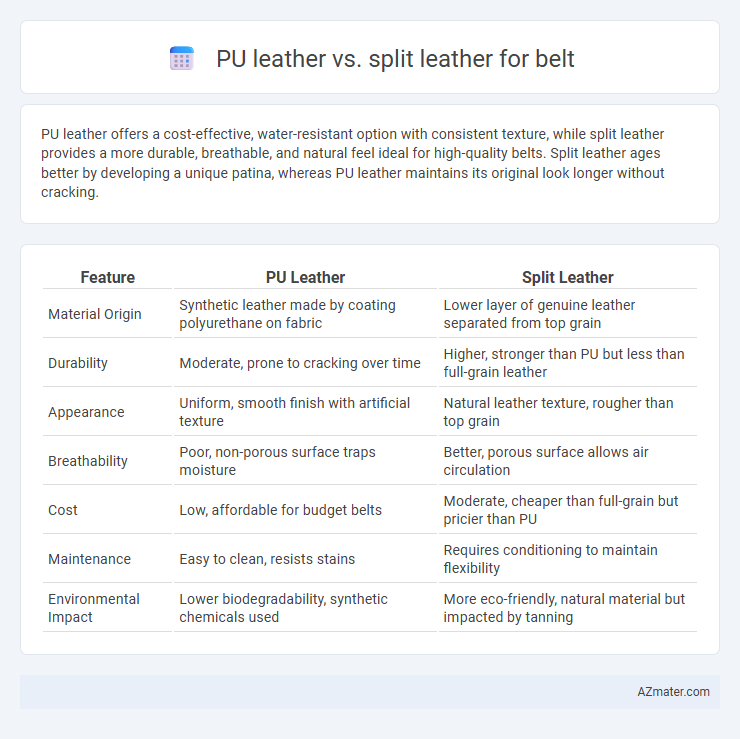PU leather offers a cost-effective, water-resistant option with consistent texture, while split leather provides a more durable, breathable, and natural feel ideal for high-quality belts. Split leather ages better by developing a unique patina, whereas PU leather maintains its original look longer without cracking.
Table of Comparison
| Feature | PU Leather | Split Leather |
|---|---|---|
| Material Origin | Synthetic leather made by coating polyurethane on fabric | Lower layer of genuine leather separated from top grain |
| Durability | Moderate, prone to cracking over time | Higher, stronger than PU but less than full-grain leather |
| Appearance | Uniform, smooth finish with artificial texture | Natural leather texture, rougher than top grain |
| Breathability | Poor, non-porous surface traps moisture | Better, porous surface allows air circulation |
| Cost | Low, affordable for budget belts | Moderate, cheaper than full-grain but pricier than PU |
| Maintenance | Easy to clean, resists stains | Requires conditioning to maintain flexibility |
| Environmental Impact | Lower biodegradability, synthetic chemicals used | More eco-friendly, natural material but impacted by tanning |
Introduction to PU Leather and Split Leather
PU leather, a synthetic material made by coating fabric with polyurethane, offers a durable and cost-effective alternative to natural leather with a smooth finish ideal for belts. Split leather, derived from the lower layers of animal hides, features a rougher texture and is often treated with a synthetic coating to enhance appearance and durability. Both materials provide unique aesthetic and functional qualities, influencing belt longevity, comfort, and price.
What is PU Leather?
PU leather, or polyurethane leather, is a synthetic material made by coating a fabric base with a layer of polyurethane, resulting in a leather-like appearance that is durable and water-resistant. Unlike genuine split leather, which is derived from the lower layers of animal hide, PU leather offers a more uniform texture and is generally more affordable, making it a popular choice for budget-friendly belts. This material requires less maintenance and resists cracking over time, but it may lack the natural breathability and patina development found in genuine split leather belts.
What is Split Leather?
Split leather refers to the inner layers of a hide that are separated from the top grain during the tanning process, offering a more affordable alternative to full-grain leather. It has a fibrous texture and is often coated or finished to mimic the appearance of higher-quality leather, making it durable yet less breathable compared to top grain options. When used in belts, split leather provides strength and a rich look but may lack the natural patina and longevity found in full-grain or genuine leather.
Appearance and Texture Comparison
PU leather belts exhibit a smooth, uniform surface with consistent color and a sleek finish that mimics genuine leather, offering a polished and modern appearance. Split leather belts feature a coarser texture with visible grain patterns and natural irregularities, providing a more rugged and authentic leather look. The softer, pliable feel of PU leather contrasts with the slightly rougher, thicker texture of split leather, influencing both comfort and style preference.
Durability and Longevity
PU leather belts offer moderate durability with a synthetic coating that resists water and stains but tend to wear out faster due to surface peeling and cracking over time. Split leather belts, made from the fibrous layer beneath the grain, provide greater longevity and toughness, as their natural texture can better withstand daily abrasion and flexing. Choosing split leather ensures a longer-lasting belt with improved resistance to wear compared to PU leather's artificial finish.
Cost and Affordability
PU leather belts offer a highly affordable option, costing significantly less than split leather belts due to synthetic manufacturing processes and lower material expenses. Split leather belts, made from the lower layers of genuine leather, generally come with higher prices reflecting better durability and natural texture. Consumers seeking budget-friendly belts typically prefer PU leather, while those valuing longevity and quality are often willing to invest more in split leather options.
Comfort and Flexibility
PU leather belts offer superior flexibility and comfort due to their synthetic construction, which allows for a softer, more pliable feel against the skin. Split leather belts, derived from the lower layers of animal hide, tend to be stiffer and less breathable, often leading to reduced comfort over prolonged wear. The enhanced elasticity of PU leather makes it ideal for those seeking a comfortable belt that conforms easily to body movements.
Maintenance and Care Requirements
PU leather belts require minimal maintenance, needing only occasional wiping with a damp cloth to remove dirt and prevent cracking. Split leather belts demand more care, including regular conditioning with leather balm to maintain suppleness and prevent drying or peeling. Both types benefit from proper storage away from direct sunlight and moisture to extend their lifespan.
Environmental Impact of Each Material
PU leather, a synthetic material made from polyurethane, offers a more environmentally friendly alternative to traditional leather by reducing the need for animal farming and limiting water usage in production. Split leather, derived from the lower layers of animal hides, involves intensive chemical treatments and tanning processes that contribute significantly to water pollution and hazardous waste generation. Choosing PU leather belts can lower ecological footprints due to fewer emissions and reduced reliance on animal agriculture compared to split leather belts.
Which Leather Type is Best for Belts?
PU leather offers a cost-effective, durable, and water-resistant option ideal for fashion belts, while split leather provides a more natural texture and breathability but is less durable than top-grain leather. Split leather belts can develop a unique patina over time, appealing to those seeking a rugged, authentic look. For long-lasting, premium quality belts, full-grain leather is often preferred over both PU and split leather due to its superior strength and aging properties.

Infographic: PU leather vs Split leather for Belt
 azmater.com
azmater.com